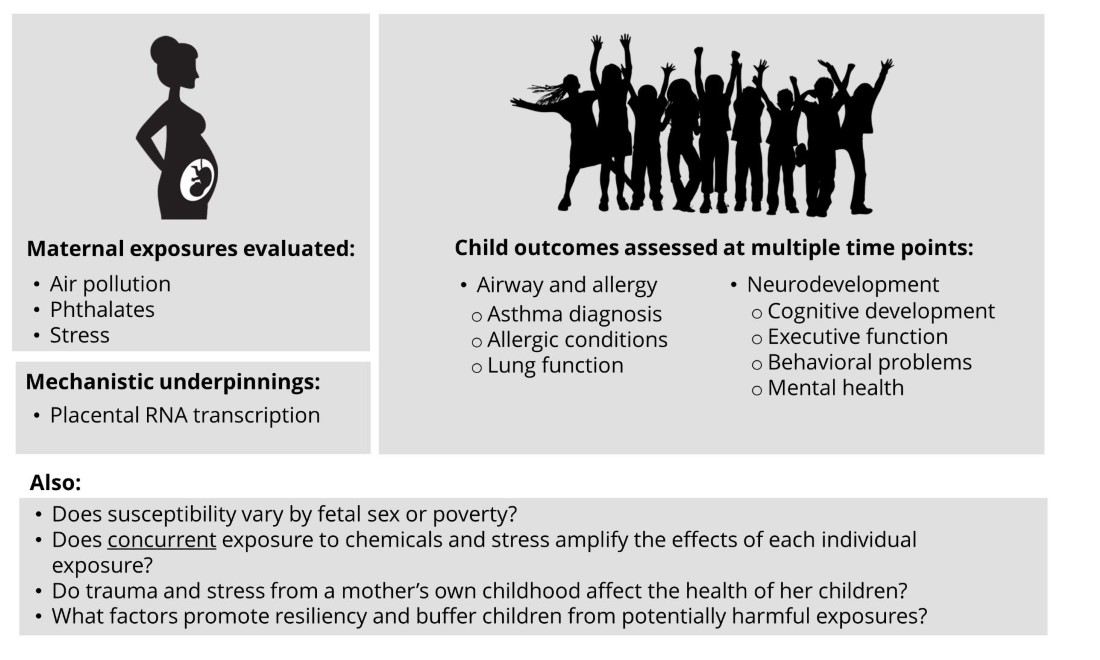Research Aims
ECHO PATHWAYS aims to unravel the complexity of factors influencing high-prevalence child health concerns in the U.S., such as asthma, depression, and anxiety. We anticipate that our findings ultimately may be used to identify high-yield intervention points as well as policy and programmatic needs.
Our research questions are focused on common exposures children face in utero and the possible adverse effects on healthy neurodevelopment and airway development (Figure 1).

Research Methods
To achieve our aims, we are collecting data on participating children and mothers longitudinally (Figure 2).
ECHO PATHWAYS builds on the legacies of the CANDLE, TIDES and GAPPS studies. Each cohort conducted extensive data collection prior to ECHO PATHWAYS, and we are centralizing these extant data into one database and standardizing data elements across cohorts (i.e., harmonizing the data)
In addition, we are extending the period of follow-up in each cohort for several years – all the way into adolescence for the oldest cohort, CANDLE – with ECHO PATHWAYS study visits. During these standardized study visits, children undergo health assessments focused on two broad domains of child development that are core to pediatric health and well-being: airway and neurodevelopment. This allows us to examine health at each time point as well as developmental trajectories across childhood.
To characterize the chemical and non-chemical environment experienced by each participating child from conception through early childhood, we are modeling outdoor air pollution, analyzing biospecimens for evidence of exposure, and administering retrospective surveys to mothers to learn about her pregnancy experiences.
We are also exploring placental gene expression as a possible mechanism by which prenatal exposures may lead to increased risk of childhood airway or neurodevelopmental disorders.
Taken together, data collection in the ECHO PATHWAYS cohort will yield a rich and large database describing the prenatal environment, placenta genomics, longitudinal child health, and many associated factors. This data repository will enable ECHO PATHWAYS investigators and collaborators to engage in cutting-edge research on environmental determinants of child airway health and neurodevelopment.
Longitudinal data collection
Study visits conducted previously by TIDES, CANDLE and GAPPS are shown in white. New ECHO PATHWAYS data collection being conducted in collaboration with our cohorts is shown in purple.
| Age | CANDLE | TIDES | GAPPS | |
|---|---|---|---|---|
| Pregnancy | T1 | T1 | T1, T2, T3 | |
| T2 | T2 | T2 | ||
| T3 | T3 | T3 | ||
| Birth | Birth | Birth | Birth | Birth |
| Childhood | 0-1 | |||
| 1-2 | 1 yr | 1 yr | ||
| 2-3 | 2 yr | 2-3 yr | ||
| 3-4 | 3 yr | |||
| 4-5 | 4 yr | 4yr | 4-6 yr 2017-2022 |
|
| 5-6 | ||||
| 6-7 | 6yr 2017-2019 |
|||
| 7-8 | 7yr 2019-2020 |
|||
| 8-9 | 8-9yr 2017-2021 |
8yr 2019-2021 |
8-9 yr 2019-2023 |
|
| 9-10 | 9yr 2020-2022 |
|||
| 10-11 | 10-11 yr 2019-2022 |
10-11 yr 2021-2023 |
||
| 11-12 | ||||
| 12-13 | 12 yr 2020-2023 |
|||
